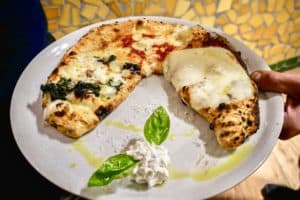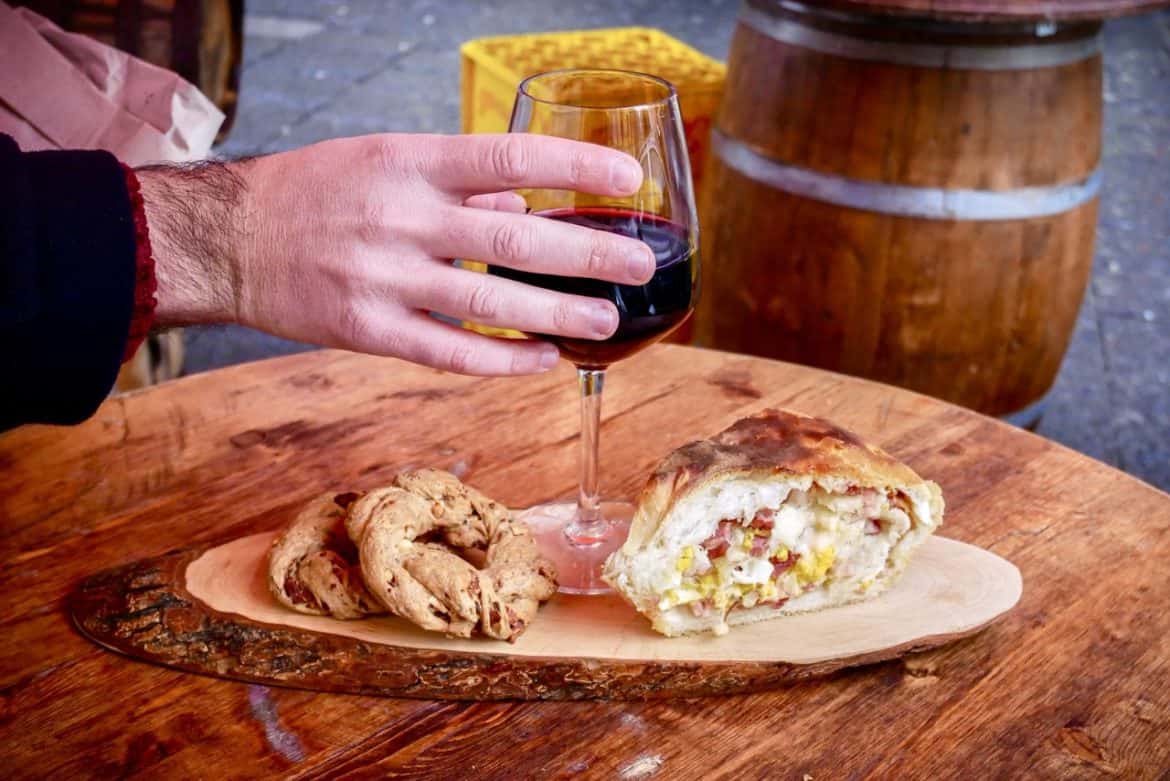Naples is famous for its culinary delights, the Neapolitan cuisine. The local food scene is rich and varied, with each dish reflecting the area’s history and passion for good food. Every meal in Naples is a chance to experience the city’s unique culture. From busy markets to cozy trattorias, Naples provides an unforgettable experience for anyone who loves good food.
The city’s reputation as a food destination is well-deserved. Naples is the birthplace of some of Italy’s most beloved dishes. The city is known for its pizza, but there’s much more to explore. Local chefs take pride in using fresh, high-quality ingredients. This commitment to quality shines through in every bite. Traditional cooking methods are passed down from family to family, ensuring that each dish is prepared with care and authenticity.
The Birthplace of Pizza
Neapolitan pizza has a storied history, deeply rooted in the heart of Naples. This beloved dish dates back to the 18th century when flatbreads topped with garlic, fat, and salt were a common food for the poor. The addition of tomatoes in the 19th century marked a turning point, transforming these simple flatbreads into what we now recognize as pizza. The classic Margherita pizza, created in honor of Queen Margherita of Savoy, symbolizes the colors of the Italian flag with its red tomatoes, white mozzarella, and green basil. This pizza has become an iconic representation of Neapolitan cuisine, showcasing the simplicity and freshness of local ingredients.
Authentic Neapolitan pizza is crafted with precision and care, using specific ingredients that are integral to its unique flavor and texture. The dough is made from just four ingredients: flour, water, salt, and yeast. It is left to rise for at least 24 hours, resulting in a soft, chewy crust with a slight crispness. San Marzano tomatoes, grown in the volcanic soil near Mount Vesuvius, provide a sweet and tangy base for the sauce. Mozzarella di bufala, a creamy cheese made from the milk of water buffalo, melts beautifully on top. Fresh basil adds a fragrant touch, while a drizzle of extra virgin olive oil enhances the overall flavor.
The key to a perfect Neapolitan pizza lies in its cooking method. Traditionally, the pizza is baked in a wood-fired oven at a high temperature, around 900°F (485°C), for just 60 to 90 seconds. This quick cooking time ensures that the crust remains soft and airy, with slight charring on the edges. The result is a pizza that is light, flavorful, and deeply satisfying.

Beyond Pizza: Must-Try Neapolitan Dishes
Neapolitan cuisine offers a variety of delicious fried appetizers that are a staple in local dining. These snacks, known as “frittura,” are perfect for starting a meal and are deeply rooted in the city’s culinary traditions. Popular options include arancini, which are rice balls filled with ragù, peas, and mozzarella, then breaded and fried to golden perfection. Another favorite is zeppole, small dough balls that are light and airy, often dusted with powdered sugar. Crocchè, made from mashed potatoes mixed with eggs, cheese, and parsley, are also breaded and fried, offering a crispy exterior and a soft, flavorful interior.
The tradition of enjoying fried appetizers dates back to ancient times when Neapolitans would gather around communal tables to share food and stories. Today, this practice continues, with frittura being an integral part of the Neapolitan food experience. Whether you’re grabbing a quick bite on the go or sitting down for a leisurely meal, these fried delights are a must-try.
Charcuterie is another essential component of Neapolitan cuisine, featuring a range of cured meats and cheeses that are rich in flavor and history. Some of the most popular meats include spicy salami, capocollo (cured pork neck), and prosciutto. These meats are often accompanied by local cheeses such as provolone and mozzarella di bufala, which add a creamy, savory element to the platter. Charcuterie plates are typically enjoyed with a glass of local wine, enhancing the flavors and providing a balanced culinary experience.
The tradition of charcuterie in Naples is rooted in the region’s agricultural practices and the preservation methods developed over centuries. These meats and cheeses are produced using time-honored techniques that ensure their quality and flavor.

The Heart of Neapolitan Cuisine
Sunday lunch is a cherished tradition, and at the heart of this meal are two classic sauces: ragù and genovese. Ragù, a slow-cooked meat sauce, is rich and hearty, made with beef, tomatoes, onions, and a touch of wine. It simmers for hours, allowing the flavors to meld together, creating a sauce that is deeply flavorful. This sauce is typically served with pasta, such as ziti or paccheri.
Unlike ragù, genovese sauce is an onion-based sauce, slow-cooked with beef until the onions break down into a sweet, caramelized puree. This sauce, despite its name, is not from Genoa but is a purely Neapolitan creation. The tender beef and onion sauce are often paired with pasta, providing a unique and delicious taste that reflects the city’s culinary ingenuity.
No Neapolitan meal is complete without indulging in the city’s famous pastries. Two of the most iconic are sfogliatella and babà. Sfogliatella, often referred to as the “lobster tail” due to its shape, is a crispy, multi-layered pastry filled with a sweet ricotta mixture. The contrast between the crunchy exterior and the creamy filling makes it a delightful treat. This pastry has a long history, originating in a convent in the 17th century, and has since become a symbol of Neapolitan pastry art.
Babà, on the other hand, is a rum-soaked cake that is moist and flavorful. This pastry, which has its roots in Poland and France, was perfected in Naples. Babà is often enjoyed plain, but it can also be filled with whipped cream or pastry cream for an extra indulgent treat.

The Neapolitan Coffee Culture
In Naples, coffee is not just a beverage; it’s an integral part of daily life. Neapolitans have a deep appreciation for espresso, which is enjoyed multiple times a day. The preparation of a perfect espresso is considered an art form. It starts with selecting the best coffee beans, which are carefully roasted to achieve a rich and bold flavor. The coffee is then brewed in a special espresso machine, creating a strong, concentrated shot of coffee that is both aromatic and flavorful.
Espresso in Naples is typically served in small cups, allowing you to savor the intense flavor in just a few sips. It’s customary to enjoy it standing at the bar, engaging in conversation with friends or even the barista.
Neapolitans have their own unique way of enjoying espresso. It is often accompanied by a glass of water to cleanse the palate before and after drinking. Some prefer their espresso with a hint of sugar, while others enjoy it plain to fully appreciate the complex flavors. Another popular variation is the “caffè sospeso” or “suspended coffee,” where you pay for two coffees but consume only one, leaving the other for someone in need. This practice embodies the spirit of generosity and community that is so important in Naples.

Experience Neapolitan Cuisine Firsthand
Our food tour in Naples is an excellent way to dive into the local cuisine. Designed to provide a comprehensive and enjoyable experience, it takes you to some of the best eateries in the city. You’ll have the opportunity to taste a variety of dishes, each carefully selected to showcase the best of Neapolitan cooking.
A guided food tour not only allows you to sample delicious dishes but also provides insights into the history and traditions behind them. Our expert local guides share stories and facts about the origins of the foods you are tasting, making the experience both educational and enjoyable. You’ll learn about the importance of local ingredients, traditional cooking methods, and the cultural significance of each dish. This deeper understanding enhances your appreciation of Neapolitan cuisine and leaves you with lasting memories of your visit.
By booking a Naples food tour, you are immersing yourself in a culinary adventure that goes beyond just eating. It’s an opportunity to connect with the city’s culture and history through its food. So, if you want to experience the true essence of Neapolitan cuisine, make sure to book your food tour today and get ready for a delicious journey through one of Italy’s most iconic culinary destinations.
